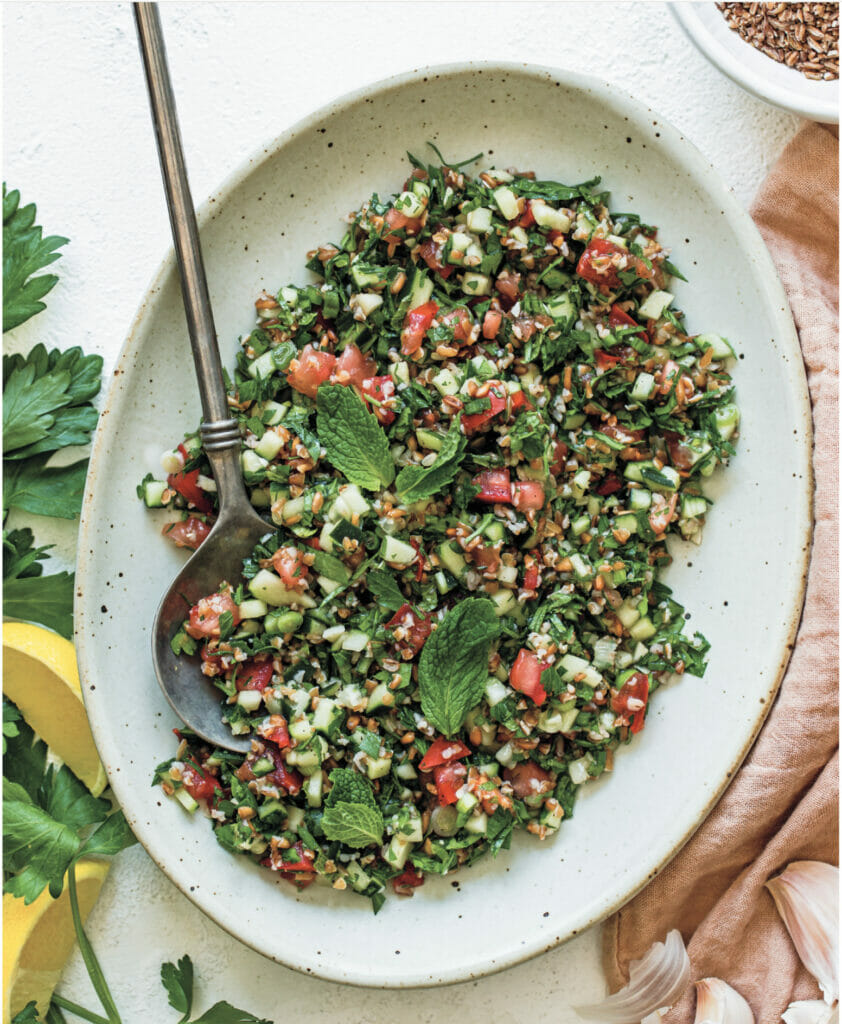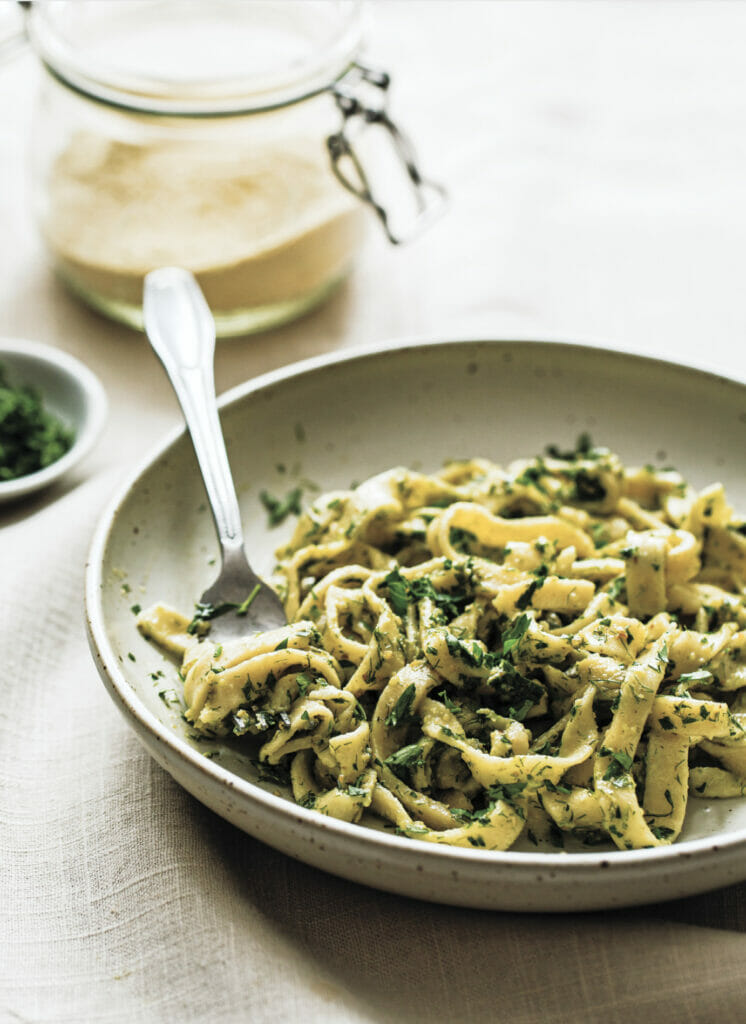Our publisher tries new cookbooks and decides if they’re worth the investment.

I was introduced to the concept of zero-waste cooking 18 months ago when I visited a restaurant in London that adhered to that philosophy. Silo Restaurant is the UK’s first zero-waste restaurant, and I left the eatery feeling grateful that someone was making a statement about food waste.
So I was excited when our editor recently suggested I try out a new cookbook, The Zero-Waste Chef by Anne-Marie Bonneau. I have been thinking a lot lately, not only about the ridiculous amount of food that goes to waste (up to 40 percent of food in the US goes uneaten), but also how we are slowly destroying our planet with toxic waste, namely plastic packaging that many food products are sold in.
Bonneau’s book begins with some startling statistics on the subject of food waste.
American consumers generate, on average, 4.5 pounds of trash per person every day, totalling 268 million tons of waste per year. Half of that ends up in landfills, which emits methane, a greenhouse gas 84 times more potent than carbon dioxide.
The amount of plastic that ends up in our oceans is also truly staggering. By 2050, some researchers estimate that there will be more plastic in our oceans than fish. Thus far, recycling efforts have not lived up to expectations. Only nine percent of plastics are actually being recycled. The rest are either burned or thrown in landfills.
The zero-waste solution addresses both food waste and the need for disposable packaging. In her book, Bonneau gives an extensive menu of tips on how to mitigate both of these problems. She gives instructions on freezing, glass jars and composting, as well as the kitchen tools needed for your entire zero-waste journey. The book also suggests how to replace plastics and other disposables.
In the recipe section, there are many examples on how to use scraps to make usable food items, such as vegetable broth. There are also recipes for food items you would normally buy in disposable packaging at your grocery store, such as ketchup or honey mustard.
Bonneau also reminds us not to stress out if we can’t achieve 100 percent zero-waste perfection. For me, this was a huge relief as it’s really hard to achieve zero waste when our food supply chain is designed almost entirely around disposable packaged goods. If each of us could achieve just 50 percent less waste, it would already be a huge improvement.
I tried two recipes from the cookbook, Lebanese Tabbouleh and Frugal Fennel-Frond Pesto Pasta. Both were very easy and quick to make. The tabbouleh was mostly simple to make without disposable packaging, as it required mostly vegetables, except for the bulgar wheat. It took trips to three different stores before I could find any, and unfortunately, it was packaged. I could have made the pasta dish without packaging, but didn’t have the time to make fresh pasta. I had to rely on packaged pasta. I hope Bonneau will forgive me. I came close.
The following is an excerpt from The Zero-Waste Chef by Anne-Marie Bonneau, reprinted with permission from Avery/Penguin Random House.
Lebanese Tabbouleh
Serves 4
1⁄2 cup bulgur (cracked wheat)
½ cup boiling water
1 large bunch fresh flat-leaf parsley, leaves finely chopped (about 2 generous cups)
1 small bunch fresh mint, leaves finely chopped (about 1⁄4 cup)
1 medium cucumber, finely chopped (about 1 cup)
1 medium ripe tomato, finely chopped (about 1 cup)
½ cup minced scallions, white and green parts
1 garlic clove, minced
2 tablespoons olive oil, or more as needed
2 tablespoons fresh lemon juice (about 1 lemon), or more as needed
1 teaspoon salt, or more as needed
Freshly ground black pepper
Unless you grow your own parsley, you must buy an entire bunch at the grocery store or farmers’ market for a recipe that might call for only a few sprigs’ worth of the vitamin- rich, dark green leafy herb. In the past, that may have caused you to skip the parsley altogether. But now you have this incredibly fresh, parsley- based salad recipe— tabbouleh. It calls for a large bunch of parsley along with mint, cucumber, tomato, onion, garlic, fresh lemon juice, and olive oil. A bit of bulgur wheat adds a hint of chewiness.
In a small heat- resistant bowl, combine the bulgur and boiling water. Set aside for 1 hour to allow the bulgur to absorb the water.
In a large bowl, combine the parsley, mint, cucumber, tomato, scallions, garlic, olive oil, lemon juice, salt, and pepper to taste.
Drain the bulgur and toss with the salad. Add more salt, lemon juice, or olive oil to taste.
Allow to sit on the counter or place in the refrigerator for 2 to 3 hours to allow the flavors to meld.
And now for your next recipe … Thick parsley stems taste much stronger than their flat leaves. But you can use them here and there rather than composting them all. Brew some tea. Toss a few stems into your stash of vegetable scraps for broth— but only a small handful, as too many of any herb will overpower the flavor. Or finely chop some and add to the black-eyed pea and mushroom burgers (page 199), fennel-frond pesto (page 209), or stir-fry (page 181).
Frugal Fennel- Frond Pesto and Pasta
At my farmers’ market, a couple of vendors give away fennel stalks and fronds. Most fennel buyers want the stalks and fronds lopped off, nipping what- on- earth- do- I- do- with- this- stuff guilt in the bulb. So, I get one of the main parts of this pesto for free— the wispy fronds. However, if this cookbook sells so well that it drives up the price of fennel fronds, I apologize.Although I have no tips on how or where to find flour for free, I can save you a lot of money on expensive tools to make pasta. Homemade pasta does turn out beautifully when you run the dough through a pasta machine, but if you don’t have one, then a work surface, a knife, and a rolling pin will suffice. And if you have a clean wine bottle, the rolling pin becomes optional, Chef MacGyver.
Make the pesto: Toast the raw nuts in the oven at 350°F for 5 minutes and stir. Toast for another 3 to 5 minutes, until fragrant but not dark.
Place the toasted nuts, garlic, fennel fronds, parsley, and salt in a food processor. Pulse to make a paste. Scrape down the sides of the food processor if necessary.
With the processor running, stream in the oil in a slow trickle, until the pesto is well blended. Transfer to a large serving bowl. (If not using immediately, refrigerate or freeze in a wide- mouth jar.)Make the pasta: Place the semolina in a large bowl and make a well in the center. Pour in the hot water. (Alternatively, you can make this directly on your work surface. For a beginner, you may prefer to use a bowl.)With a fork, incorporate the flour from the edges of the well into the water. Continue until you’ve combined all the flour and water and have formed a crumbly dough.
Serves 3
For the Pesto
1⁄4 cup raw nuts, such as walnuts, pecans, almonds, or hazelnuts
2 garlic cloves, smashed
1 cup packed fennel fronds (see Note)
½ cup packed fresh parsley leaves
½ teaspoon salt
1⁄4 cup olive oil
For the Pasta
21⁄2 cups (250 g) durum semolina
3⁄4 cup (125 ml) hot, not boiling, water
1 teaspoon salt
Turn the dough out onto a floured surface. The bowl will likely contain enough unincorporated flour that you won’t need more on your work surface. Knead the dough until it is smooth and elastic. It should spring back after you make an indentation in it with your thumb. If it doesn’t spring back, keep kneading it. This can take about 10 minutes. Cover with a clean dish towel and let rest for 20 to 30 minutes.
Divide the dough into 2 equal portions; smaller portions are easier to work with. Lightly dust the work surface with semolina, if necessary, as you roll out each piece of the dough to about 1/8 inch thick.
Dust the dough with semolina. Roll each piece of the dough up into a very loose tube (see the picture opposite). You will be slicing noodles from these tubes, so you don’t want it too tightly wound and stuck together. Cut 1/4- inch- wide noodles from each roll.
Add the salt to a large pot of water and bring to a boil. Add the noodles and cook until tender, about 2 minutes. Reserve at least 1/3 cup of the pasta cooking water. Drain the pasta in a colander. Whisk the saved pasta cooking water into the bowl with the pesto. Blend and toss the pasta in the pesto and serve
Note:
The pesto recipe works well with kale stems also. Replace the fennel fronds with 1 cup of 1⁄2- inch pieces of kale stems.
And now for your next recipe … You now have leftover fennel stalks. Shave them with a vegetable peeler and add them to a salad, such as the bean, vegetable, and grain salad with lemon-garlic dressing (page 206).

